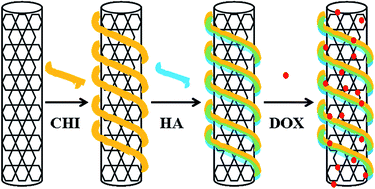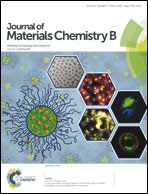Controlled release and targeted delivery to cancer cells of doxorubicin from polysaccharide-functionalised single-walled carbon nanotubes†
Abstract
Carboxyl single-walled carbon nanotubes (SWNTs) were used to construct an innovative drug delivery system by modification with chitosan (CHI) to enhance water solubility and biocompatibility. Hyaluronan (HA), as the target ligand for CD44, was bound to the CHI layer to selectively kill cancer cells. To achieve a new treatment strategy for cancer, the drug delivery system was loaded with the anticancer drug doxorubicin hydrochloride (DOX). The data showed that the system loaded with DOX with zeta potentials of 8.52 ± 0.12 mV at pH 7.4 and 12.53 ± 0.23 mV at pH 5.5 had high drug-loading efficiency, reaching 107.73 ± 0.67%. It also exhibited sustained and controlled drug-release, depending on pH; it released less than 10% at pH 7.4 but nearly 85% at pH 5.5 after 72 h. Cell viability results indicated that the drug delivery system effectively killed HeLa cells while it had lower cytotoxicity against fibroblasts. Combined histological examinations and blood property analyses demonstrated that it did not cause severe damage to vital organs in SD rats. Thus, this drug delivery system may provide a high therapeutic efficacy for cancer, while minimising adverse side effects.


 Please wait while we load your content...
Please wait while we load your content...